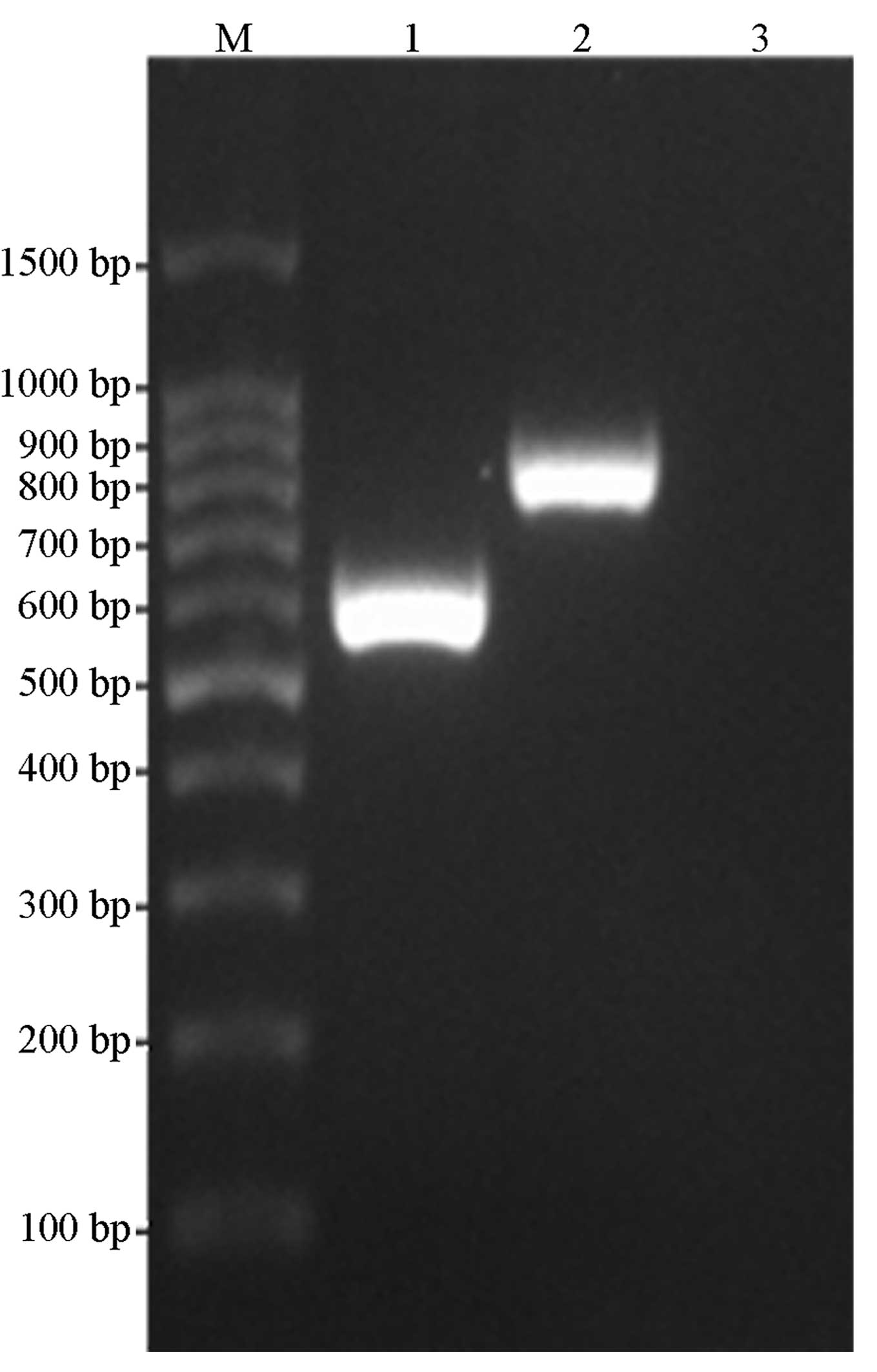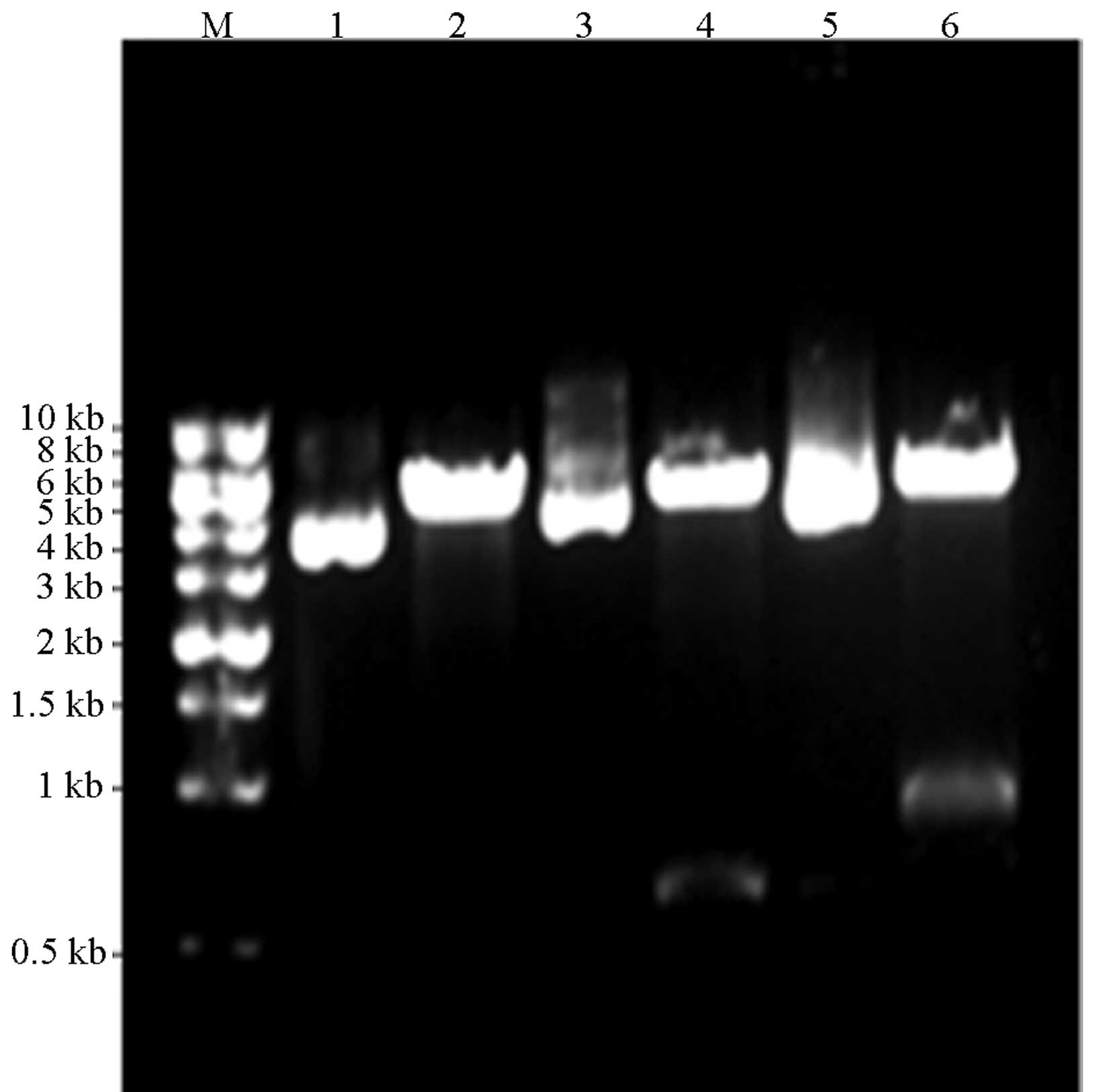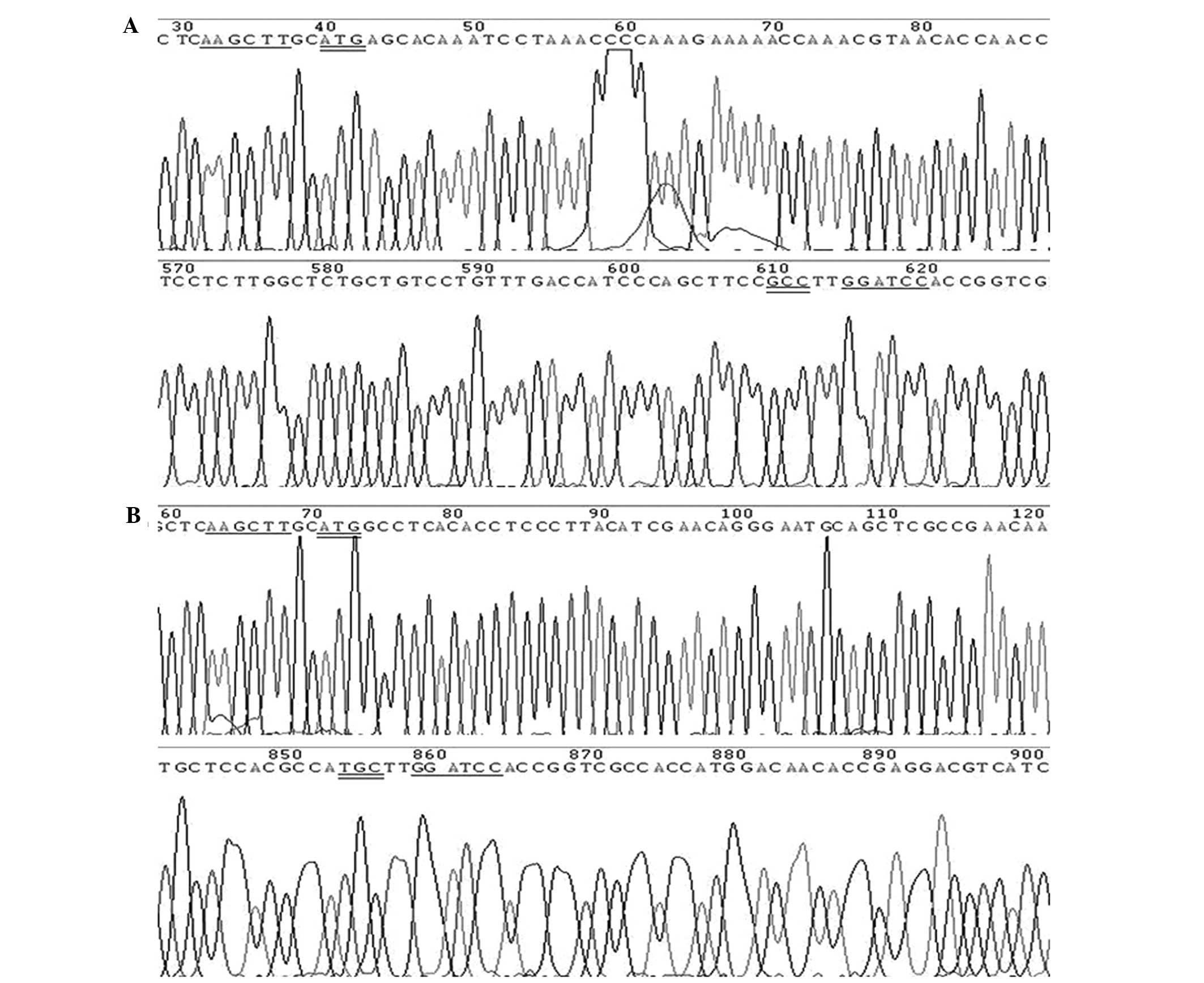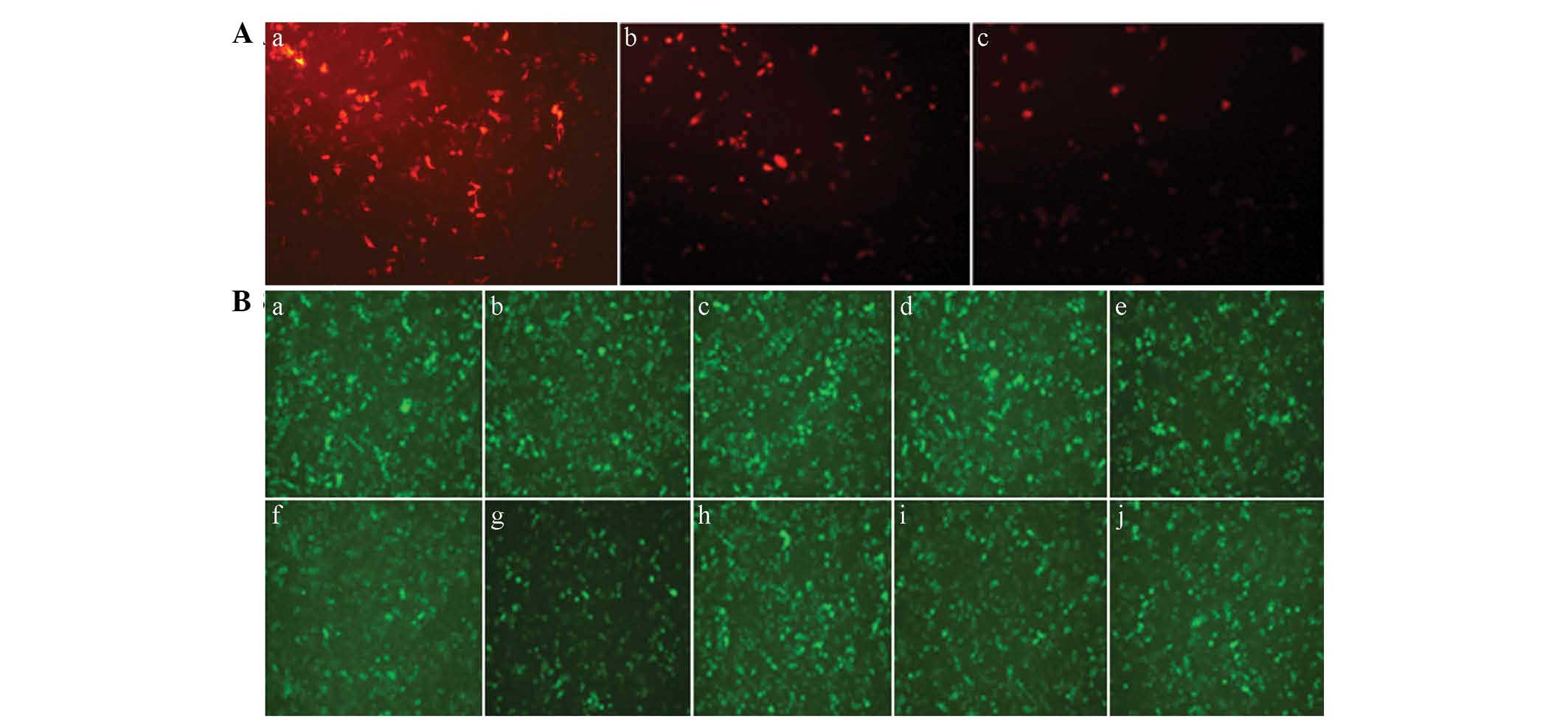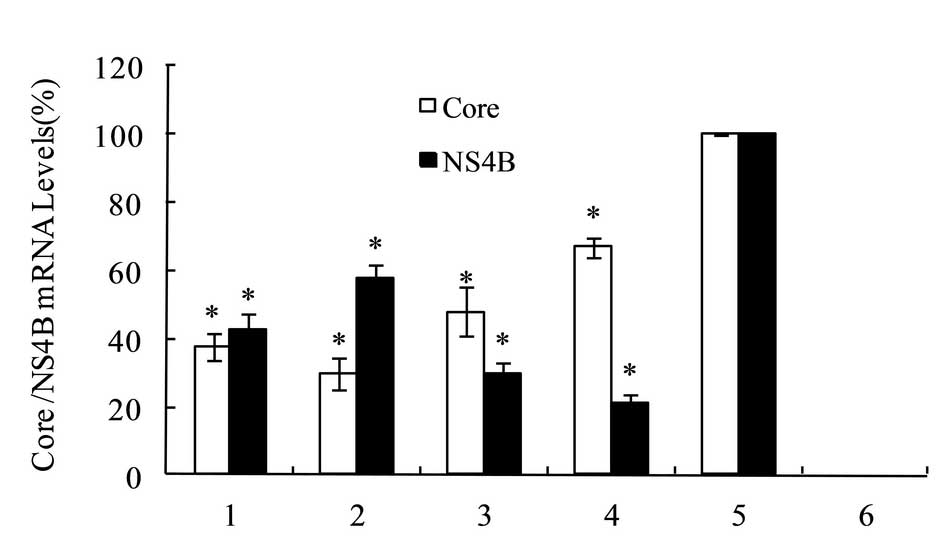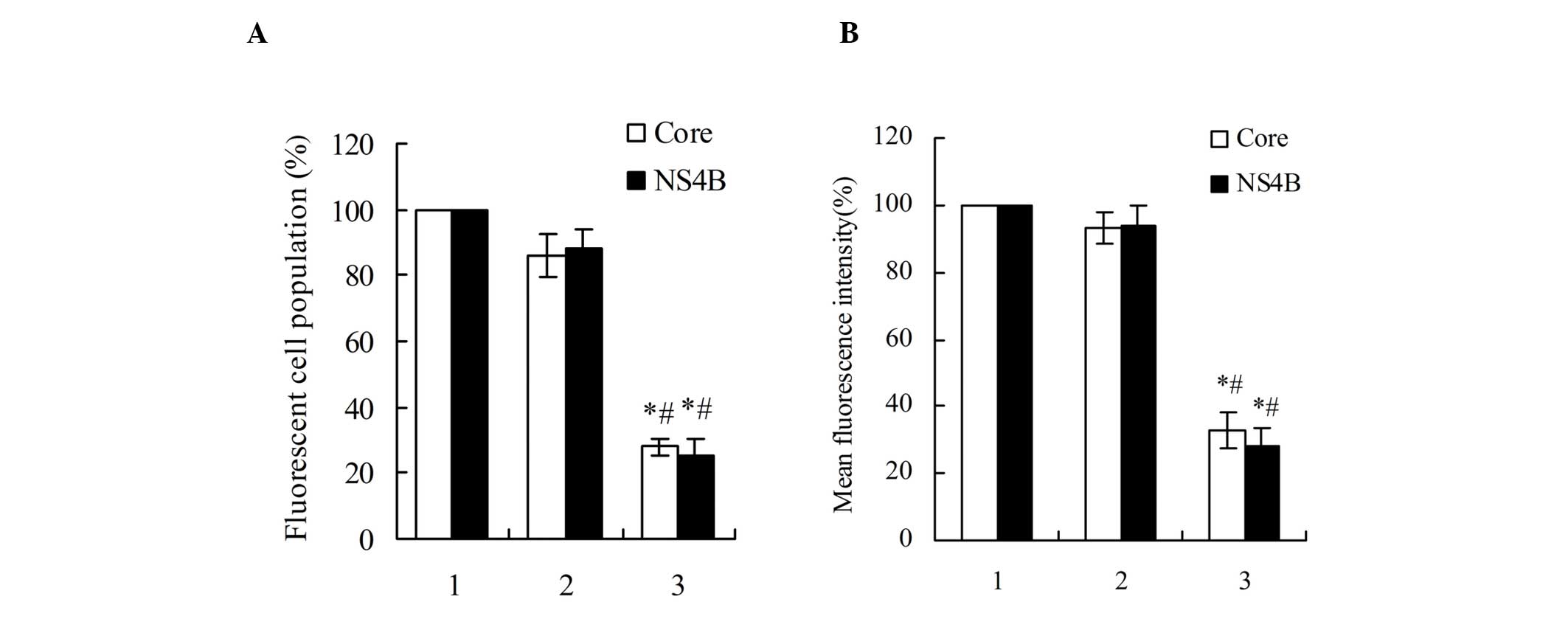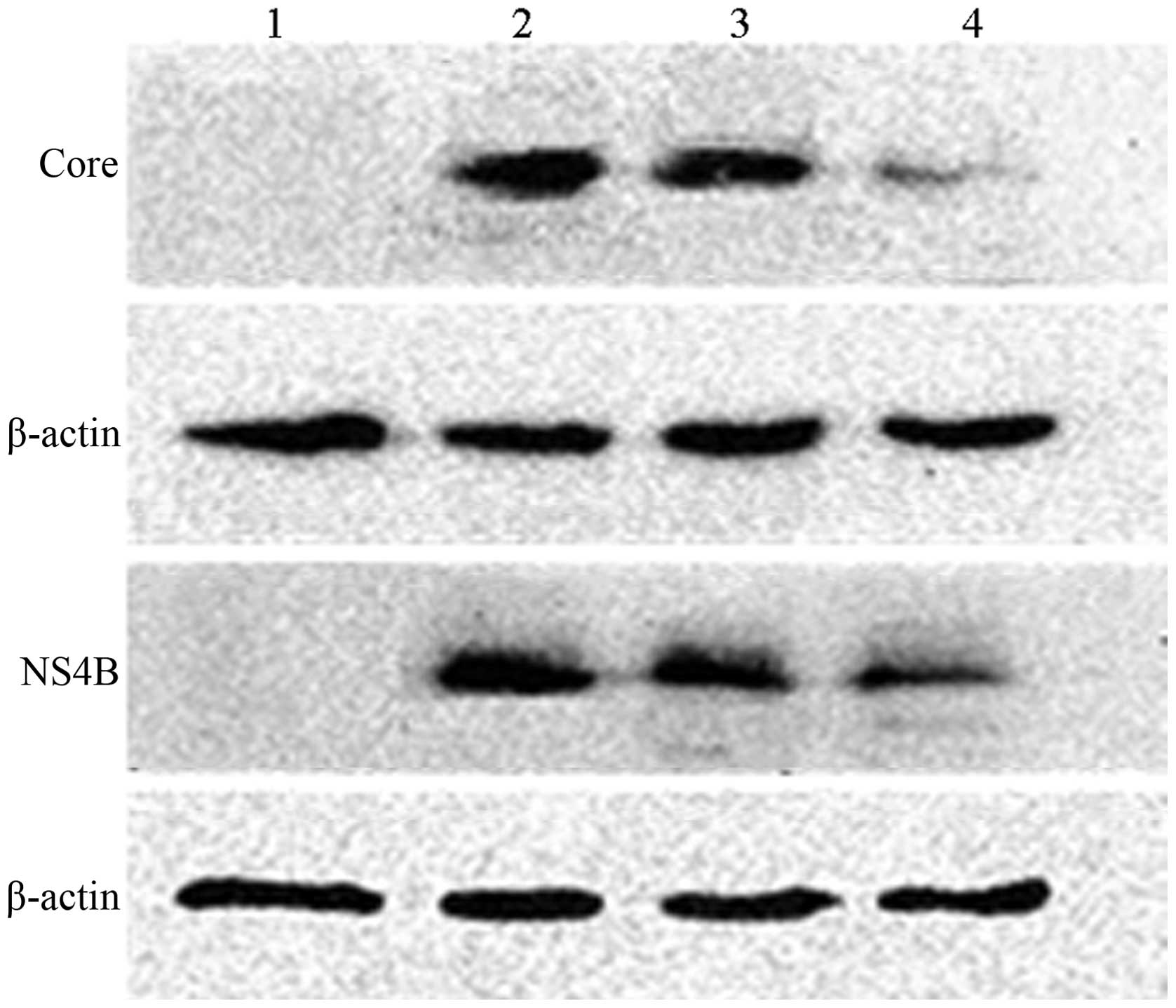Inhibition of expression of hepatitis C virus 1b genotype core and NS4B genes in HepG2 cells using artificial microRNAs
- Authors:
- Published online on: March 31, 2015 https://doi.org/10.3892/mmr.2015.3571
- Pages: 1905-1913
Abstract
Introduction
The hepatitis C virus (HCV) is a major cause of chronic hepatitis, cirrhosis and hepatocellular carcinoma (1,2). An estimated 185 million people around the world are infected with HCV, with three to four million new cases each year (3). However, the pathogenesis of HCV remains to be fully elucidated. The standard of care (SOC) for HCV is the combined application of pegylated interferon α and ribavirin, with a sustained virological response (SVR) rate of up to 50%; however, the various genetic subtypes of HCV exhibit differing response rates to treatment (4). In addition, the treatment cost is high and there is a significant risk of side effects (5,6). The development of small molecule inhibitors targeting HCV replication-associated enzymes has recently achieved success in HCV therapy, with a significant increase in SVR (7–10). Despite this advance, the issue of resistance remains a problem (11,12), even when used in combination therapy with the SOC. Therefore, the development of novel antiviral strategies is required in order to more effectively treat HCV infection.
RNA interference (RNAi) is a post-transcriptional cellular process mediated by short (21–25 nucleotides) double-stranded RNA molecules (13), which are capable of gene silencing (14–17). MicroRNAs (miRNAs) are members of this group of small RNAs. The primary miRNAs are processed by the Drosha ribozyme and DGCR8 into precursor miRNAs consisting of 60–70 nucleotides (18). These miRNAs are subsequently exported from the nucleus by Exportin-5 (19), and processed into mature miRNAs by the ribonuclease-III enzyme Dicer (18). The guiding strand of the mature miRNA is then loaded into the RNA-induced silencing complex (20) to form the miRNA-containing ribonucleoprotein complex (miRNP), which is able to mediate the cleavage of target mRNA or result in translational repression (16). Artificial miRNAs (amiRNAs) comprise a class of artificially synthesized RNAs (21), similar to cellular miRNAs, which may be harnessed to silence mRNAs encoding pathogenic proteins for use in therapeutic strategies and functional genomics (22).
The HCV genome is a 9.6 kb positive-stranded RNA molecule containing a long open reading frame encoding a polyprotein precursor, which is processed by cellular and viral proteases into structural (Core, E1 and E2) and nonstructural (p7, NS2, NS3, NS4A, NS4B, NS5A and NS5B) proteins. The HCV core protein is a conserved protein, which comprises the viral nucleocapsid and is able to bind viral RNA. The HCV core protein is also a multifunctional, influencing gene transcription, lipid metabolism, apoptosis and a variety of signal transduction pathways in host cells (23–26). In addition, the core protein has been implicated in HCV-associated steatosis and carcinogenesis in transgenic mice (27,28). This protein is hypothesized to serve a function in the assembly of HCV (29). HCVNS4B is a hydrophobic integral membrane protein that has a central function in the formation of the membranous web; a specific membrane alteration, which serves as a scaffold for the HCV replication complex (30–32). In addition, NS4B possesses NTPase (33,34) and RNA-binding activities (35), as well as contributing to viral assembly and release (36,37). Therefore, HCV core and NS4B mRNAs may be used as targets for RNAi.
In the present study, two sets of amiRNA expression vectors were designed and constructed against the HCV1b genotype core and NS4B mRNAs, in order to evaluate the interference efficiency of amiRNAs on HCV core and NS4B gene expression in HepG2 cells. In addition, the present study aimed to screen the optimum miRNA interference vectors for use in subsequent studies on the functions and pathogenesis of HCV core and NS4B genes, as well as the examination of novel classes of inhibitors for HCV infection.
Materials and methods
Collection of serum samples
A total of 15 patients with HCV1b were enrolled in the present study from the First Affiliated Hospital of The University of South China (Hengyang, China). The patients included 7 males and 8 females, and were aged between 27 and 66 years old. The venous blood samples of the patients were collected by a trained nurse at the Research Center of Liver Diseases (First Affiliated Hospital of the University of South China). After centrifugation at 241 × g for 10 min at room temperature, the serum was obtained and preserved at −80°C until further use. The quantification and genotyping of HCV RNA were performed by the Research Center of Liver Diseases. The present study was conducted in accordance with the Declaration of Helsinki, and with approval from the Ethics Committee of Central South University (Changsha, China). Written informed consent was obtained from all participants.
Construction of plasmids
TRIzol reagent (Invitrogen Life Technologies, Carlsbad, CA, USA) was used to extract HCV RNA from the serum of HCV1b patients. The serum was then reverse transcribed into cDNA using the SuperScript III First-strand synthesis system (Invitrogen Life Technologies). Subsequently, polymerase chain reaction (PCR) amplification was performed with gene-specific primers (Shanghai Sangon Biological Technology and Services Co., Ltd., Shanghai, China). The primer sequences of the core gene amplification in the first round were as follows: HCV1b sense, 5′-GAGTAGYGT TGGGTCGCGAAAGG-3′ and antisense, 5′-TTGAGTTGGAGCAGTCGTTCGTGA-3′. In the second round, the PCR primer sequences were as follows: HCV1b sense, 5′-GCCACGAAG CTTGCATGAGCACRAATCCWAAAC-3′ (AAGCTT is the enzyme restriction site of HindIII) and antisense, 5′-TAGATTGGATCCAARGCGGAAGCTGGGRTGGTC-3′ (GGATCC is the enzyme restriction site of BamHI). The primer sequences of NS4B gene amplification in the first round were as follows: NS4B sense, 5-′GAGTGCGCYTCRCACCTCCCT TA-3′ and antisense, 5′-CGGAGCAYGGYGTGGAGCAG-3′. In the second round, the PCR sense primer sequences were as follows: NS4B sense, 5′-GTCCAGAAGCTTGCATGGCYTCRCACCTCCCTTA-3′ (AAGCTT is the enzyme restriction site of HindIII) and antisense, 5′-TAGATTGGATCCAAGCAYGGYGTGGAGCAGTCCT-3′ (GGATCC is the enzyme restriction site of BamHI). The PCR conditions consisted of pre-denaturation, 94°C for 3 min; denaturation, 94°C for 30 sec; annealing, 61°C for 30 sec and extension, 72°C for 1 min. This cycle was repeated 35 times with a final extension at 72°C for 10 min. The amplified HCV1bCore and HCV1bNS4B genes contained the double-enzyme restriction sites of HindIII and BamHI (Fermentas International Inc., Burlington, ON, Canada), which were then used to digest the two aforementioned target fragments and vector pDsRed-monomer-N1 (Clontech, Mountain View, CA, USA). Following purification, the two digested fragments were connected with the vectors using T4 DNA ligase (Fermentas International Inc.), and were then transformed into DH5α competent cells (preserved in the Laboratory of Infectious Diseases, Xiangya Hospital, Changsha, China) to construct the plasmids of pDsRed-monomer-Core and pDsRed-monomer-NS4B. The constructed plasmids were then subjected to double digestion and sequencing (Invitrogen Life Technologies, Shanghai, China).
Construction of miRNA expression vectors
The HCV core and NS4B genetic information was submitted through the BLOCK-iT™ RNAi Express database (http://rnaidesigner.invitrogen.com/rnaiexpress/rnaiExpress.jsp) to select the interference sites. The gene specificity of all interference sites was also assessed using the Basic Local Alignment Search Tool (BLAST; http://blast.ncbi.nlm.nih.gov/Blast.cgi). A total of two sets of miRNA interference sequences were designed and the single-stranded DNA oligonucleotides (Invitrogen Life Technologies) of eight pairs of miRNAs and those of a negative control miRNA, were synthesized. The sequences are shown in Table I. The eight pairs of single-stranded DNA oligonucleotides were then annealed and the double strands were formed. The vector construction kit BLOCK-iT™ Pol II miR RNAi expression vector kit with Emerald Green Fluorescent Protein (EmGFP) (Invitrogen Life Technologies, Carlsbad, CA, USA) was then used to recombine the clones. A total of eight pairs of double-stranded oligonucleotides were inserted into the miRNA expression vector pcDNA™ 6.2-GW/EmGFP-miR to construct eight miRNA expression plasmids for core silencing (pmiRE-C-mi1 to -mi4) and NS4B silencing (pmiRE-NS4B-mi1 to -mi4). The above plasmids were transformed into DH5α competent cells. Following agitation extraction using TIANprep Mini Plasmid kit (Tiangen Biotech (Beijing) Co., Ltd., Beijing, China) in a SHZ-88 Thermostatic Oscillator (Jintan Medical Instrument Factory, Changzhou, China), the extracted plasmids were sequenced, using the reverse sequencing primer 5′-CTCTAGATCAACCACTTTGT-3′, to verify whether the fragment sequence inserted into the recombinant clones was consistent with the designed single-stranded DNA oligonucleotide sequence.
Table ISequences of oligonucleotides for microRNAs directed against hepatitis C virus 1b core and non-structural protein 4B genes. |
Cell culture and transfection
HepG2 cells (preserved in the Laboratory of Infectious Diseases, Xiangya Hospital) were cultivated in Dulbecco’s modified Eagle’s medium supplemented with 10% fetal bovine serum (FBS; Invitrogen Life Technologies) in a humidified 5% CO2 atmosphere at 37°C. HepG2 cells at the logarithmic growth phase were seeded into six-well plates at a density of ~1.0×106 cells/well. When the cell density reached ~80%, 1 µg target gene plasmid and 3 µg interference plasmid or negative control plasmid were mixed with Lipofectamine® 2000 (Invitrogen Life Technologies). The transfection was performed according to the Lipofectamine 2000 manufacturer’s instructions. Following 48 h, the transfected-cellular fluorescent protein expression was observed under a fluorescence microscope (Olympus IX71; Olympus Corp., Tokyo, Japan).
Reverse transcription quantitative PCR (RT-qPCR)
At 48 h post-transfection, the total RNA of each group was extracted using TRIzol reagent (Invitrogen Life Technologies). Subsequently, 5 µg of RNA was reverse transcribed into cDNA with SuperScript III reverse transcriptase (Invitrogen Life Technologies). The obtained cDNA was then used as the template for the PCR reaction. The primer sequences were as follows: HCV core sense, 5′-TACGGCAACGAGGGCTTAG-3′ and antisense, 5′-ATGGTCAAACAGGACAGCAGAG-3′; NS4B sense, 5′-CTCGCCGAACAATTCAAGC-3′ and antisense, 5′-GTTCCCAGGCAGAGTGGATAA-3′; and GAPDH sense, 5′-GAAGGTCGGAGTCAACGGATT-3′ and antisense, 5′-CGCTCCTGGAAGATGGTGAT-3′ (Shanghai Sangon Biological Technology and Services Co., Ltd.). The PCR reaction mixture consisted of 1.2 µl cDNA, 2.5 µl 10X PCR buffer, 0.2 µl dNTPs (25 mM), 0.5 µl each of upstream and downstream primers (10 µM), 0.5 µl SYBR (50X), 0.3 µl of Taq enzyme (5u/µl), 2 µl of Mg2+ (25 mM) and 17.3 µl of ultrapure water (Shanghai Sangon Biological Technology and Services Co., Ltd.). The total volume of the reaction mixture was 25 µl. The PCR reaction conditions were as follows: 95°C for 2 min; 95°C for 10 sec, 60°C for 30 sec and 70°C for 45 sec for 40 cycles. All RT-qPCR experiments were performed in triplicate on a 7500 Fast real-time PCR system (Applied Biosystems, Foster City, CA, USA). Based on the RT-qPCR reaction curve, the Ct values of the target gene and reference gene of each sample were obtained using the 2−ΔΔCt method for the relative quantification. The interference efficiency of the target gene was 1–2−ΔΔCt.
Flow cytometric analysis
The two RT-qPCR-screened miRNA vectors with the greatest interfering effects against the HCV core and NS4B genes, as well as the negative control miRNA vector, were co-transfected with the cells containing the target gene for 48 h. The cells were then digested with 0.25% trypsin (Fuzhou Maixin Biotechnology Development Co., Ltd., Fuzhou, China), washed twice with phosphate-buffered saline (PBS; Fuzhou Maixin Biotechnology Development Co., Ltd.) and resuspended in PBS. Samples were subsequently assessed using a FACS Calibur flow cytometer (Becton Dickinson, Franklin Lakes, NJ, USA) to calculate the percentage of fluorescent cells and the mean fluorescence intensity.
Western blot analysis
The two screened miRNA vectors with the optimum interfering effects, as well as the negative control miRNA vector, were co-transfected into the cells with the target gene for 48 h. The cells were then lysed with radioimmunoprecipitation assay buffer (Beyotime Institute of Biotechnology, Jiangsu, China). Following centrifugation at 1,048 × g for 5 min at 4°C, the supernatant was collected for protein concentration detection. Subsequently, 60 µg of protein was separated using 10% sodium dodecyl sulfate-polyacrylamide gel electrophoresis and transferred onto a nitrocellulose membrane (Bio-Rad Laboratories, Inc., Hercules, CA, USA) under semi-dry conditions. Blots were blocked with 5% non-fat milk (Beyotime Institute of Biotechnology) in Tris-buffered saline with 0.1% Tween 20 (Sigma-Aldrich, St. Louis, MO, USA) at room temperature for 2 h. The membrane was incubated overnight at 4°C with the following primary antibodies: Mouse anti-HCV core antigen antibody (cat. no. ab2740; 1:1,000 dilution; Abcam, Cambridge, UK), mouse anti-HCV NS4B monoclonal antibody (cat. no. ab24283; 1:1,000 dilution; Abcam) and β-actin antibody (cat. no. sc-47778; 1:1,000 dilution; Santa Cruz Biotechnology, Inc., Dallas, TX, USA). Following washing the membrane, the blots were incubated with horseradish peroxidase-conjugated goat anti-mouse immunoglobulin G (cat. no. A0216; 1:5,000 dilution; Beyotime Institute of Biotechnology) at room temperature for 2 h. The signals were revealed with the BeyoECL Plus enhanced chemiluminescent kit (Beyotime Institute of Biotechnology).
Statistical analysis
Statistical analyses were carried out using SPSS version 16.0 software (SPSS Inc., Chicago, IL, USA). Data are expressed as the mean ± standard deviation. Significance between groups was determined by one-way analysis of variance followed by a Student-Newman-Keuls post hoc test. P<0.05 was considered to indicate a statistically significant difference.
Results
Construction of plasmids
The target gene-expressing plasmids, pDsRed-monomer-Core and pDsRed-monomer-NS4B, were subjected to PCR amplification, double-enzyme digestion and sequencing. The results were consistent with the expected values, whereby the PCR gene products of the HCV core and NS4B proteins were ~580 and 790 bp, respectively and the digested fragment of pDsRed-monomer-N1 was ~4.7kb, as shown in Figs. 1 and 2. The DNA sequencing results confirmed that two recombinant plasmids were efficiently constructed. Partial sequencing peak patterns of the recombinant pDsRed-monomer-Core and pDsRed-monomer-NS4B plasmids are shown in Fig. 3.
Construction of miRNA expression vectors
A total of eight miRNA expression plasmids, pmiRE-C-mi1 to -mi4 and pmiRE-NS4B-mi1 to -mi4, were verified to contain identical designed single-stranded DNA oligonucleotide sequences using the sequencing test, relative to the inserted fragment sequences (data not shown).
Expression of fluorescent proteins
A fluorescence microscope was used to observe the fluorescent protein expression 48 h after the cells were transfected (Fig. 4). The fluorescence of the pDesRed-monomer-N1 (53.80±3.56%) was more evident, as compared with that of the pDsRed-monomer-Core (32.17±3.82%) and the pDsRed-monomer-NS4B (32.73±3.45%), respectively (P<0.01). At 48 h post-transfection of the eight pairs of miRNA expression plasmids, the cells of each group exhibited green fluorescent protein expression indicating successful transfection.
Expression of HCV core and NS4B mRNAs
RT-qPCR was performed to assess the mRNA expression levels of HCV core or NS4B in the HepG2 cells. The expression levels of core or NS4B gene in HepG2 cells, which had been co-transfected by the negative control miRNA and pDsRed-monomer-Core or pDsRed-monomer-NS4B were set as 100%. pmiRE-C-mi1 to -mi4 was co-transfected into the HepG2 cells with pDsRed-monomer-Core. The relative expression levels of core mRNA were 38.0±4.0, 30.0±4.6, 48.0±7.2 and 67.0±3.0%, respectively. The pmiRE-NS4B-mi1 to -mi4 was co-transfected into the HepG2 cells with pDsRed-monomer-NS4B, and the relative expression levels of NS4B mRNA were 43.0±4.6, 58.0±4.0, 30.0±3.0 and 21.0±3.0%, respectively. The results are shown in Fig. 5. The results indicated that among the HCV core interference vectors, the optimum gene silencing effect of was a reduction of 70%, exerted by pmiRE-C-mi2; whereas, among the HCVNS4B interference vectors, the optimum gene silencing effect was a decrease of 79%, induced by pmiRE-NS4B-mi4.
Expression of HCV core and NS4B proteins
Flow cytometric analysis revealed that the single transfection of pDsRed-monomer-Core or pDsRed-monomer-NS4B into the HepG2 cells, when compared with the HepG2 cells that were co-transfected by the negative control miRNA and pDsRed-monomer-Core or pDsRed-monomer-NS4B, exhibited no significant differences in terms of red fluorescent protein percentage and average fluorescence intensity. In addition, the pDsRed-monomer-Core and pmiRE-C-mi2 co-transfected HepG2 cells exhibited a reduced percentage of red fluorescent protein expression and average fluorescence intensity by 2.5 and 2.0-fold, respectively. The red fluorescent protein percentage and average fluorescence intensity in the pDsRed-monomer-NS4B and pmiRE-NS4B-mi4 co-transfected HepG2 cells were also decreased by 3.0 and 2.6-fold, respectively, as shown in Fig. 6.
Western blot analysis revealed that, compared with the HepG2 cells that were transfected by the pDsRed-monomer-Core only, the pDsRed-monomer-Core and pmiRE-C-mi2 co-transfected HepG2 cells exhibited reduced expression of the HCV core protein; whereas expression levels in the pDsRed-monomer-Core and negative control miRNA co-transfected HepG2 cells were not decreased. Similar results were also observed in the expression of NS4B protein, as shown in Fig. 7.
Discussion
RNAi has become a powerful tool, with the potential to knock down the expression of disease-associated genes or inhibit viral gene expression (38). HCV is comprised of a positive-stranded RNA virus, containing a single-stranded RNA genome, which functions as mRNA for the translation of viral proteins and the template for RNA replication (39). As replication occurs in the cytoplasm of liver cells without integration into the host genome DNA, HCV has emerged as a target of RNAi (40). Certain in vivo and in vitro experiments have demonstrated that exogenously administered short-interfering RNAs are able to exert replication inhibition against a variety of viruses (41–44). In the present study, two sets of amiRNA expression vectors were designed and constructed against HCV1b genotype core and NS4B mRNAs, and it was investigated whether these amiRNAs were capable of efficiently inhibiting the expression of the HCV core and NS4B genes.
miRNAs are small non-coding RNA molecules, consisting of ~22 nucleotides, which may be incorporated into miRNP complexes and are able to induce mRNA degradation or translational repression by binding to the 3′-untranslated regions of their target mRNAs (45–48). The HCV core consists of three distinct domains: An N-terminal hydrophilic domain of ~120 amino acids, termed domain D1; a C-terminal hydrophobic domain of ~50 amino acids, termed domain D2; and the last 20 amino acids are designated as the signal peptide of the downstream protein E1 (49). The domain D1 is mainly involved in RNA binding and nucleocapsid formation. The domain D2 is responsible for core association with lipid droplets in mammalian cells and with the membrane of the endoplasmic reticulum (50). Previous studies have revealed that expression levels of the HCV core protein are correlated with the occurrence of hepatic steatosis, oxidative stress and hepatocellular carcinoma (27,28,51). The HCV core protein may also have a function in HCV assembly (29). NS4B is an integral membrane protein, which performs an essential function in HCV replication (52–54). The NS4B protein may induce the formation of the membranous web structure, which was hypothesized to represent the platform upon which HCV replication is performed (30–32). The NS4B protein also interacts with NS4A, and indirectly interacts with NS3 and NS5A (55). In addition, NS4B has been found to exhibit NTPase (33,34) and RNA binding (35) activities. Recently, NS4B has been reported to regulate HCV genome encapsidation (36). In the present study, the silencing effects of amiRNAs on the expression of HCV core and NS4B genes were investigated. The RT-qPCR method was used to detect the mRNA levels of HCV core and NS4B genes and the results demonstrated that in the miRNA-transfected HepG2 cells, the mRNA levels of HCV core and NS4B genes were effectively reduced. C-mi2 was identified for its efficient silencing effect toward the core gene C-terminal domain (amino acids 117–124), which is required for the folding and stability of the core protein (49), reducing the expression of the core gene to 70% at the transcriptional level. NS4B-mi4 was also identified for its effective silencing effect toward the NS4B gene C-terminal domain (amino acids 240–247), which can mediate membrane association (56) and reduce the expression of the NS4B gene to 79% at the transcriptional level.
To clarify whether amiRNAs were able to effectively inhibit the expression of target gene proteins in HepG2 cells, flow cytometric analysis was applied. It was revealed that the red fluorescent protein percentage and average fluorescence intensity in the miRNA-transfected HepG2 cells were significantly reduced, compared with those of the negative control miRNA-transfected HepG2 cells. Western blot analysis revealed that the core and NS4B protein levels in the miRNA-transfected cells were also significantly reduced compared with the negative control miRNA-transfected cells, further confirming that the HCV core and NS4B-targeting miRNAs were able to effectively inhibit the expression of target genes. The results of the present study are supported by multiple studies, demonstrating that amiRNAs are able to effectively inhibit the replication of the rabies virus (57), adenoviruses (58), the human immunodeficiency virus (59) and the HCV (60).
The results of the present study also demonstrated that the amiRNAs designed against various domains of the HCV core and NS4B genes exhibited differing silencing effects against the target genes in the HepG2 cells, which may be attributed to the specific conformations between the miRNP and target mRNAs. Therefore, the biological activities varied and influenced the interference efficiency. Specific amiRNAs exhibit differing silencing effects, such that the expressed miRNAs cannot completely inhibit the expression of target genes. For this reason, targeting multiple domains of the HCV genome associated with HCV replication may be an effective method for the inhibition of viral gene expression and prevention of the generation of viral resistance.
In conclusion, the present data indicated that the expression of amiRNAs may effectively and specifically inhibit the expression of target HCV core and NS4B genes in HepG2 cells in vitro, providing a powerful tool for follow-up studies regarding HCV core and NS4B gene functions and pathogenesis. This approach is expected to become a novel therapeutic strategy for anti-HCV treatment.
References
|
Alter MJ: Epidemiology of hepatitis C virus infection. World J Gastroenterol. 13:2436–2441. 2007. View Article : Google Scholar : PubMed/NCBI | |
|
Lavanchy D: The global burden of hepatitis C. Liver Int. 29:74–81. 2009. View Article : Google Scholar : PubMed/NCBI | |
|
Mohd Hanafiah K, Groeger J, Flaxman AD and Wiersma ST: Global epidemiology of hepatitis C virus infection: New estimates of age-specific antibody to HCV seroprevalence. Hepatology. 57:1333–1342. 2013. View Article : Google Scholar | |
|
Zhu Y and Chen S: Antiviral treatment of hepatitis C virus infection and factors affecting efficacy. World J Gastroenterol. 19:8963–8973. 2013. View Article : Google Scholar : | |
|
Sarasin-Filipowicz M: Interferon therapy of hepatitis C: molecular insights into success and failure. Swiss Med Wkly. 140:3–11. 2010. | |
|
Feld JJ: The beginning of the end: what is the future of interferon therapy for chronic hepatitis C? Antiviral Res. 105:32–38. 2014. View Article : Google Scholar : PubMed/NCBI | |
|
Poordad F, McCone J Jr, Bacon BR, et al: Boceprevir for untreated chronic HCV genotype 1 infection. N Engl J Med. 364:1195–1206. 2011. View Article : Google Scholar : PubMed/NCBI | |
|
Jacobson IM, McHutchison JG, Dusheiko G, et al: Telaprevir for previously untreated chronic hepatitis C virus infection. N Engl J Med. 364:2405–2416. 2011. View Article : Google Scholar : PubMed/NCBI | |
|
Gane EJ, Stedman CA, Hyland RH, et al: Nucleotide polymerase inhibitor sofosbuvir plus ribavirin for hepatitis C. N Engl J Med. 368:34–44. 2013. View Article : Google Scholar : PubMed/NCBI | |
|
Lawitz E, Mangia A, Wyles D, et al: Sofosbuvir for previously untreated chronic hepatitis C infection. N Engl J Med. 368:1878–1887. 2013. View Article : Google Scholar : PubMed/NCBI | |
|
Pawlotsky JM: Treatment failure and resistance with direct-acting antiviral drugs against hepatitis C virus. Hepatology. 53:1742–1751. 2011. View Article : Google Scholar : PubMed/NCBI | |
|
Wyles DL: Beyond telaprevir and boceprevir: resistance and new agents for hepatitis C virus infection. Top Antivir Med. 20:139–145. 2012.PubMed/NCBI | |
|
Fire A, Xu S, Montgomery MK, Kostas SA, Driver SE and Mello CC: Potent and specific genetic interference by double-stranded RNA in Caenorhabditis elegans. Nature. 391:806–811. 1998. View Article : Google Scholar : PubMed/NCBI | |
|
Fire A: RNA-triggered gene silencing. Trends Genet. 15:358–363. 1999. View Article : Google Scholar : PubMed/NCBI | |
|
Carthew RW and Sontheimer EJ: Origins and mechanisms of miRNAs and siRNAs. Cell. 136:642–655. 2009. View Article : Google Scholar : PubMed/NCBI | |
|
Huntzinger E and Izaurralde E: Gene silencing by microRNAs: contributions of translational repression and mRNA decay. Nat Rev Genet. 12:99–110. 2011. View Article : Google Scholar : PubMed/NCBI | |
|
Kawamata T and Tomari Y: Making RISC. Trends Biochem Sci. 35:368–376. 2010. View Article : Google Scholar : PubMed/NCBI | |
|
Cullen BR: Transcription and processing of human microRNA precursors. Mol Cell. 16:861–865. 2004. View Article : Google Scholar : PubMed/NCBI | |
|
Yi R, Qin Y, Macara IG and Cullen BR: Exportin-5 mediates the nuclear export of pre-microRNAs and short hairpin RNAs. Genes Dev. 17:3011–3016. 2003. View Article : Google Scholar : PubMed/NCBI | |
|
Sontheimer EJ: Assembly and function of RNA silencing complexes. Nat Rev Mol Cell Biol. 6:127–138. 2005. View Article : Google Scholar : PubMed/NCBI | |
|
Zeng Y, Wagner EJ and Cullen BR: Both natural and designed microRNAs can inhibit the expression of cognate mRNAs when expressed in human cells. Mol Cell. 9:1327–1333. 2002. View Article : Google Scholar : PubMed/NCBI | |
|
Baumann V and Winkler J: miRNA-based therapies: Strategies and delivery platforms for oligonucleotide and non-oligonucleotide agents. Future Med Chem. 6:1967–1984. 2014. View Article : Google Scholar : PubMed/NCBI | |
|
Fukutomi T, Zhou Y, Kawai S, Eguchi H, Wands JR and Li J: Hepatitis C virus core protein stimulates hepatocyte growth: correlation with upregulation of wnt-1 expression. Hepatology. 41:1096–1105. 2005. View Article : Google Scholar : PubMed/NCBI | |
|
Boulant S, Douglas MW, Moody L, Budkowska A, Targett-Adams P and McLauchlan J: Hepatitis C virus core protein induces lipid droplet redistribution in a microtubule- and dynein-dependent manner. Traffic. 9:1268–1282. 2008. View Article : Google Scholar : PubMed/NCBI | |
|
Sato Y, Kato J, Takimoto R, et al: Hepatitis C virus core protein promotes proliferation of human hepatoma cells through enhancement of transforming growth factor α expression via activation of nuclear factor-κB. Gut. 55:1801–1808. 2006. View Article : Google Scholar : PubMed/NCBI | |
|
Park J, Kang W, Ryu SW, et al: Hepatitis C virus infection enhances TNF-α-induced cell death via suppression of nuclear factor-κB. Hepatology. 56:831–840. 2012. View Article : Google Scholar : PubMed/NCBI | |
|
Lerat H, Honda M, Beard MR, et al: Steatosis and liver cancer in transgenic mice expressing the structural and nonstructural proteins of hepatitis C virus. Gastroenterology. 122:352–365. 2002. View Article : Google Scholar : PubMed/NCBI | |
|
Moriya K, Fujie H, Shintani Y, et al: The core protein of hepatitis C virus induce hepatocellular carcinoma in transgenic mice. Nat Med. 4:1065–1067. 1998. View Article : Google Scholar : PubMed/NCBI | |
|
Neveu G, Barouch-Bentov R, Ziv-Av A, Gerber D, Jacob Y and Einav S: Identification and targeting of an interaction between a tyrosine motif within hepatitis C virus core protein and AP2M1 essential for viral assembly. PLoS Pathog. 8:e10028452012. View Article : Google Scholar : PubMed/NCBI | |
|
Egger D, Wölk B, Gosert R, Bianchi L, Blum HE, Moradpour D and Bienz K: Expression of hepatitis C virus proteins induces distinct membrane alterations including a candidate viral replication complex. J Virol. 76:5974–5984. 2002. View Article : Google Scholar : PubMed/NCBI | |
|
Hügle T, Fehrmann F, Bieck E, et al: The hepatitis C virus nonstructural protein 4B is an integral endoplasmic reticulum membrane protein. Virology. 284:70–81. 2001. View Article : Google Scholar : PubMed/NCBI | |
|
Gosert R, Egger D, Lohmann V, Bartenschlager R, Blum HE, Bien K and Moradpour D: Identification of the hepatitis C virus RNA replication complex in Huh7 cells harboring subgenomic replicons. J Virol. 77:5487–5492. 2003. View Article : Google Scholar : PubMed/NCBI | |
|
Einav S, Elazar M, Danieli T and Glenn JS: A nucleotide binding motif in hepatitis C virus (HCV) NS4B mediates HCV RNA replication. J Virol. 78:11288–11295. 2004. View Article : Google Scholar : PubMed/NCBI | |
|
Thompson AA, Zou A, Yan J, et al: Biochemical characterization of recombinant hepatitis C virus nonstructural protein 4B: evidence for ATP/GTP hydrolysis and adenylate kinase activity. Biochemistry. 48:906–916. 2009. View Article : Google Scholar : PubMed/NCBI | |
|
Einav S, Gerber D, Bryson PD, et al: Discovery of a hepatitis C target and its pharmacological inhibitors by microfluidic affinity analysis. Nat Biotechnol. 26:1019–1027. 2008. View Article : Google Scholar : PubMed/NCBI | |
|
Han Q, Manna D, Belton K, Cole R and Konan KV: Modulation of hepatitis C virus genome encapsidation by nonstructural protein 4B. J Virol. 87:7409–7422. 2013. View Article : Google Scholar : PubMed/NCBI | |
|
Jones DM, Patel AH, Targett-Adams P and McLauchlan J: The hepatitis C virus NS4B protein can trans-complement viral RNA replication and modulates production of infectious virus. J Virol. 83:2163–2177. 2009. View Article : Google Scholar : | |
|
Davidson BL and McCray PB Jr: Current prospects for RNA interference-based therapies. Nat Rev Genet. 12:329–340. 2011. View Article : Google Scholar : PubMed/NCBI | |
|
Tang H and Grisé H: Cellular and molecular biology of HCV infection and hepatitis. Clin Sci (Lond). 117:49–65. 2009. View Article : Google Scholar | |
|
Arbuthnot P: Harnessing RNA interference for the treatment of viral infections. Drug News Perspect. 23:341–350. 2010.PubMed/NCBI | |
|
Zhou J and Rossi JJ: Progress in RNAi-based antiviral therapeutics. Methods Mol Biol. 721:67–75. 2011.PubMed/NCBI | |
|
Khaliq S, Jahan S, Ijaz B, et al: Inhibition of core gene of HCV 3a genotype using synthetic and vector derived siRNAs. Virol J. 7:3182010. View Article : Google Scholar : PubMed/NCBI | |
|
Ali Ashfaq U, Ansar M, Sarwar MT, Javed T, Rehman S and Riazuddin S: Post-transcriptional inhibition of hepatitis C virus replication through small interference RNA. Virol J. 8:1122011. View Article : Google Scholar : PubMed/NCBI | |
|
DeVincenzo JP: The promise, pitfalls and progress of RNA-interference-based antiviral therapy for respiratory viruses. Antivir Ther. 17(1 Pt B): 213–225. 2012. View Article : Google Scholar : PubMed/NCBI | |
|
Ambros V: The functions of animal microRNAs. Nature. 431:350–355. 2004. View Article : Google Scholar : PubMed/NCBI | |
|
Zhang R and Su B: Small but influential: the role of microRNAs on gene regulatory network and 3′UTR evolution. J Genet Genomics. 36:1–6. 2009. View Article : Google Scholar : PubMed/NCBI | |
|
Pillai RS, Bhattacharyya SN, Artus CG, et al: Inhibition of translational initiation by Let-7 MicroRNA in human cells. Science. 309:1573–1576. 2005. View Article : Google Scholar : PubMed/NCBI | |
|
Shukla GC, Singh J and Barik S: MicroRNAs: processing, maturation, target recognition and regulatory functions. Mol Cell Pharmacol. 3:83–92. 2011.PubMed/NCBI | |
|
Boulant S, Vanbelle C, Ebel C, Penin F and Lavergne JP: Hepatitis C virus core protein is a dimeric alpha-helical protein exhibiting membrane protein features. J Virol. 79:11353–11365. 2005. View Article : Google Scholar : PubMed/NCBI | |
|
Boulant S, Montserret R, Hope RG, et al: Structural determinants that target the hepatitis C virus core protein to lipid droplets. J Biol Chem. 281:22236–22247. 2006. View Article : Google Scholar : PubMed/NCBI | |
|
Moriya K, Nakagawa K, Santa T, et al: Oxidative stress in the absence of inflammation in a mouse model for hepatitis C virus-associated hepatocarcinogenesis. Cancer Res. 61:4365–4370. 2001.PubMed/NCBI | |
|
Dvory-Sobol H, Pang PS and Glenn JS: The future of HCV therapy: NS4B as an antiviral target. Viruses. 2:2481–2492. 2010. View Article : Google Scholar : PubMed/NCBI | |
|
Gouttenoire J, Penin F and Moradpour D: Hepatitis C virus nonstructural protein 4B: a journey into unexplored territory. Rev Med Virol. 20:117–129. 2010. View Article : Google Scholar : PubMed/NCBI | |
|
Rai R and Deval J: New opportunities in anti-hepatitis C virus drug discovery: targeting NS4B. Antiviral Res. 90:93–101. 2011. View Article : Google Scholar : PubMed/NCBI | |
|
Lin C, Wu JW, Hsiao K and Su MS: The hepatitis C virus NS4A protein: interactions with the NS4B and NS5A proteins. J Virol. 71:6465–6471. 1997.PubMed/NCBI | |
|
Gouttenoire J, Montserret R, Kennel A, Penin F and Moradpour D: An amphipathic α-helix at the C terminus of hepatitis C virus nonstructural protein 4B mediates membrane association. J Virol. 83:11378–11384. 2009. View Article : Google Scholar : PubMed/NCBI | |
|
Israsena N, Supavonwong P, Ratanasetyuth N, Khawplod P and Hemachudha T: Inhibition of rabies virus replication by multiple artificial microRNAs. Antiviral Res. 84:76–83. 2009. View Article : Google Scholar : PubMed/NCBI | |
|
Ibrišimović M, Kneidinger D, Lion T and Klein R: An adenoviral vector-based expression and delivery system for the inhibition of wild-type adenovirus replication by artificial microRNAs. Antiviral Res. 97:10–23. 2013. View Article : Google Scholar | |
|
Kato K, Senoki T and Takaku H: Inhibition of HIV-1 replication by RNA with a microRNA-like function. Int J Mol Med. 31:252–258. 2013. | |
|
Yang X, Haurigot V, Zhou S, Luo G and Couto LB: Inhibition of hepatitis C virus replication using adeno-associated virus vector delivery of an exogenous anti-hepatitis C virus microRNA cluster. Hepatology. 52:1877–1887. 2010. View Article : Google Scholar : PubMed/NCBI |



